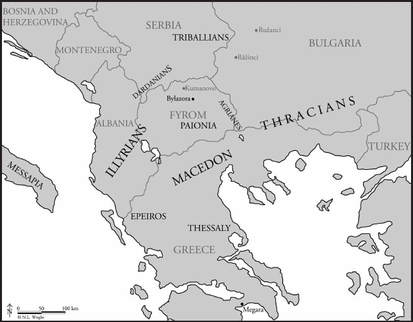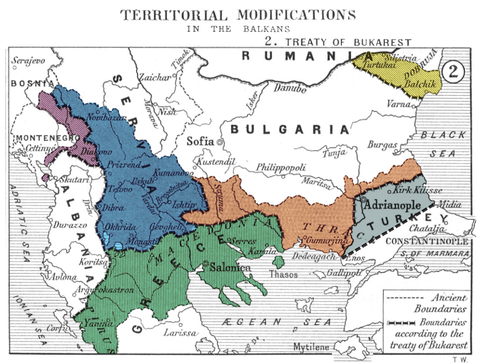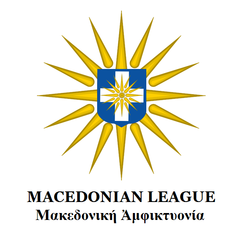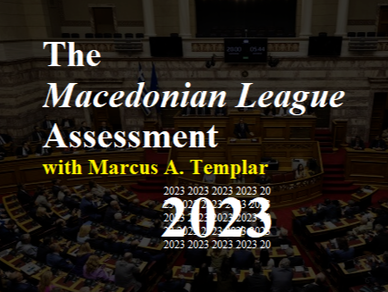Marcus A. Templar, National Security Advisor | Macedonian League
 Photo credit: Dr. Nicholas L. Wright, Field Archaeologist and Numismatist
Photo credit: Dr. Nicholas L. Wright, Field Archaeologist and Numismatist It is routinely publicized that the Peace Treaty of Bucharest split "Macedonia" into three segments. According to this information, Greece received 51.56%, Serbia 38.32%, and Bulgaria 10.12%. The above information is incorrect, because it is based on false assumptions. Over 90% of true Macedonia is within Greece.
If by Macedonia one considers the conquest of the area of ancient Paionia (i.e. the FYROM), following the same logic one has to consider Afghanistan as being Macedonia, as well. Macedonia is considered only the region that at the ancient times was inhabited by the Macedonian Greeks. Conquests are temporary; they do not count.
>> FIRST ASSUMPTION: the Existence of the "Macedonian" People in 1913
One of the main cries of the FYROM Slavs is that Greece denies the existence of the "Macedonian" people. The FYROM historians claim that the "Macedonians" are the ones who created the Ilinden Uprising, but as we saw above, the insurgents were Bulgarians living in geographic Macedonia. Not one of them was ethnic "Macedonian." The FYROM Slavs further state that the Carnegie report uses the term "Macedonian" in an ethnic sense.
If by Macedonia one considers the conquest of the area of ancient Paionia (i.e. the FYROM), following the same logic one has to consider Afghanistan as being Macedonia, as well. Macedonia is considered only the region that at the ancient times was inhabited by the Macedonian Greeks. Conquests are temporary; they do not count.
>> FIRST ASSUMPTION: the Existence of the "Macedonian" People in 1913
One of the main cries of the FYROM Slavs is that Greece denies the existence of the "Macedonian" people. The FYROM historians claim that the "Macedonians" are the ones who created the Ilinden Uprising, but as we saw above, the insurgents were Bulgarians living in geographic Macedonia. Not one of them was ethnic "Macedonian." The FYROM Slavs further state that the Carnegie report uses the term "Macedonian" in an ethnic sense.
 Photo credit: Marcus A. Templar
Photo credit: Marcus A. TemplarNational Security Advisor, Macedonian League
However, the Carnegie report refers only to the Bulgarians and Greeks living in Macedonia. When the report suggests the adjective "Macedonian," it clearly means and without any exception all inhabitants of Macedonia in the spirit of the Manifesto of Krushevo. As pointed out above, the Slavic people of Macedonia kept declaring themselves ethnically Bulgarian. Brailsford, in his famous book regarding Macedonia, used the term Macedonian as a geographic term that encompassed Turks, Greeks, Bulgarians, Serbs, Albanians, Gypsies, Jews, Dönme, and others.
>> SECOND ASSUMPTION: The Treaty split Macedonian Territories in 1913
The area of Macedonia would have been "51.56% to Greece, 38.32% to Serbia, 10.12% to Bulgaria" if Macedonia included the FYROM areas north of Gradsko and Bakarno Gumno - Krushevo. Nevertheless, that is not the case.
Dr. Fanula Papazoglu stated that Macedonia's territory reached as north as the area of Bakarno Gumno in the towns of Krushevo and Prilep, which means that the areas north of Gradsko were not included in Macedonia even in modern times. If the whole area of the FYROM was within Macedonia in 1913 when the Treaty of Bucharest was signed, is it not interesting that the borders were moved in 1917 and later by 100 kilometers to the south? Taking into consideration the above, one could argue that the division was more or less 70% to Greece, 11 % to Bulgaria, and 16% to Serbia and a strip of 3% to Albania." The Academy of Athens elevates the territories of the Macedonian Homeland belonging presently to Greece to 90%.
In the same interview, Fanula Dimitriou-Papazoglou told the author that before WWII Skopje was an Old Serbian town and the Capital of the pre-War Vardarska Banovina. She also stated that the only reason for it being the capital of the newly emerged People's Republic of Macedonia was that it was the largest city in the area. Bitola was too small.
>> SECOND ASSUMPTION: The Treaty split Macedonian Territories in 1913
The area of Macedonia would have been "51.56% to Greece, 38.32% to Serbia, 10.12% to Bulgaria" if Macedonia included the FYROM areas north of Gradsko and Bakarno Gumno - Krushevo. Nevertheless, that is not the case.
Dr. Fanula Papazoglu stated that Macedonia's territory reached as north as the area of Bakarno Gumno in the towns of Krushevo and Prilep, which means that the areas north of Gradsko were not included in Macedonia even in modern times. If the whole area of the FYROM was within Macedonia in 1913 when the Treaty of Bucharest was signed, is it not interesting that the borders were moved in 1917 and later by 100 kilometers to the south? Taking into consideration the above, one could argue that the division was more or less 70% to Greece, 11 % to Bulgaria, and 16% to Serbia and a strip of 3% to Albania." The Academy of Athens elevates the territories of the Macedonian Homeland belonging presently to Greece to 90%.
In the same interview, Fanula Dimitriou-Papazoglou told the author that before WWII Skopje was an Old Serbian town and the Capital of the pre-War Vardarska Banovina. She also stated that the only reason for it being the capital of the newly emerged People's Republic of Macedonia was that it was the largest city in the area. Bitola was too small.
 Photo credit: Public Domain | Territorial Modifications in the Balkans
Photo credit: Public Domain | Territorial Modifications in the Balkans according to the Treaty of Bucharest
Immediately after the division of the Ottoman vilayets of Selanik and Manastir, the Greek government established the "General Administration of Macedonia" for its part of Macedonia, officially recognizing and utilizing the term Macedonia first after the fall of the Byzantine Empire. “The Treaty of Neuilly of 1919 ‘corrected’ the few errors of the Treaty of Bucharest of 1913 and re-christened Serbia's and Greece's part of Macedonia South Serbia and Northern Greece respectively.”
>> THIRD ASSUMPTION: The Treaty of Bucharest has an expiry
The FYROM Slavs created this assumption for internal consumption starting with the misinterpretation of President Gligorov's statement requesting the revision of the Treaty of Bucharest, but externally it indicates ignorance because treaties setting borders are permanent. The only treaties that include in their text an expiry are treaties of leasing with a usual clause of 99 years.
In order for the treaty of Bucharest to be officially re-visited, it would require all signatory countries to exclusively agree to it, something that would be nearly impossible since many countries' national interests and their stability would be directly or indirectly affected. Since this Treaty is one of the fundamental treaties that set some of the borders in the Balkans, a revision or re-negotiation of the treaty would set a chain reaction that would invalidate or alter successive treaties. In the end, the opening and renegotiation of the treaty would not guarantee that the FYROM would gain territories, nor would it guarantee the FYROM's own existence.
>> THIRD ASSUMPTION: The Treaty of Bucharest has an expiry
The FYROM Slavs created this assumption for internal consumption starting with the misinterpretation of President Gligorov's statement requesting the revision of the Treaty of Bucharest, but externally it indicates ignorance because treaties setting borders are permanent. The only treaties that include in their text an expiry are treaties of leasing with a usual clause of 99 years.
In order for the treaty of Bucharest to be officially re-visited, it would require all signatory countries to exclusively agree to it, something that would be nearly impossible since many countries' national interests and their stability would be directly or indirectly affected. Since this Treaty is one of the fundamental treaties that set some of the borders in the Balkans, a revision or re-negotiation of the treaty would set a chain reaction that would invalidate or alter successive treaties. In the end, the opening and renegotiation of the treaty would not guarantee that the FYROM would gain territories, nor would it guarantee the FYROM's own existence.




 RSS Feed
RSS Feed